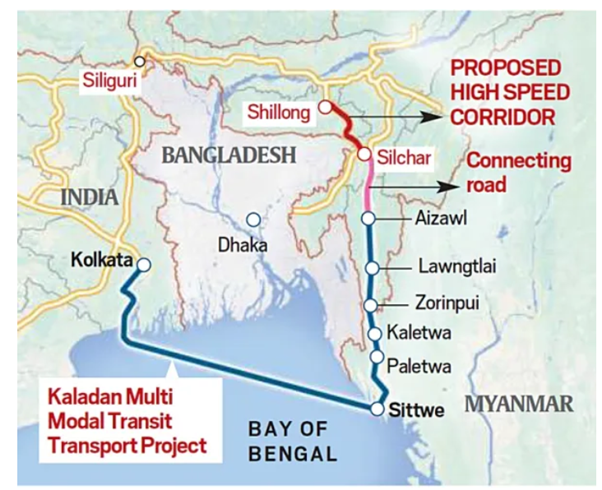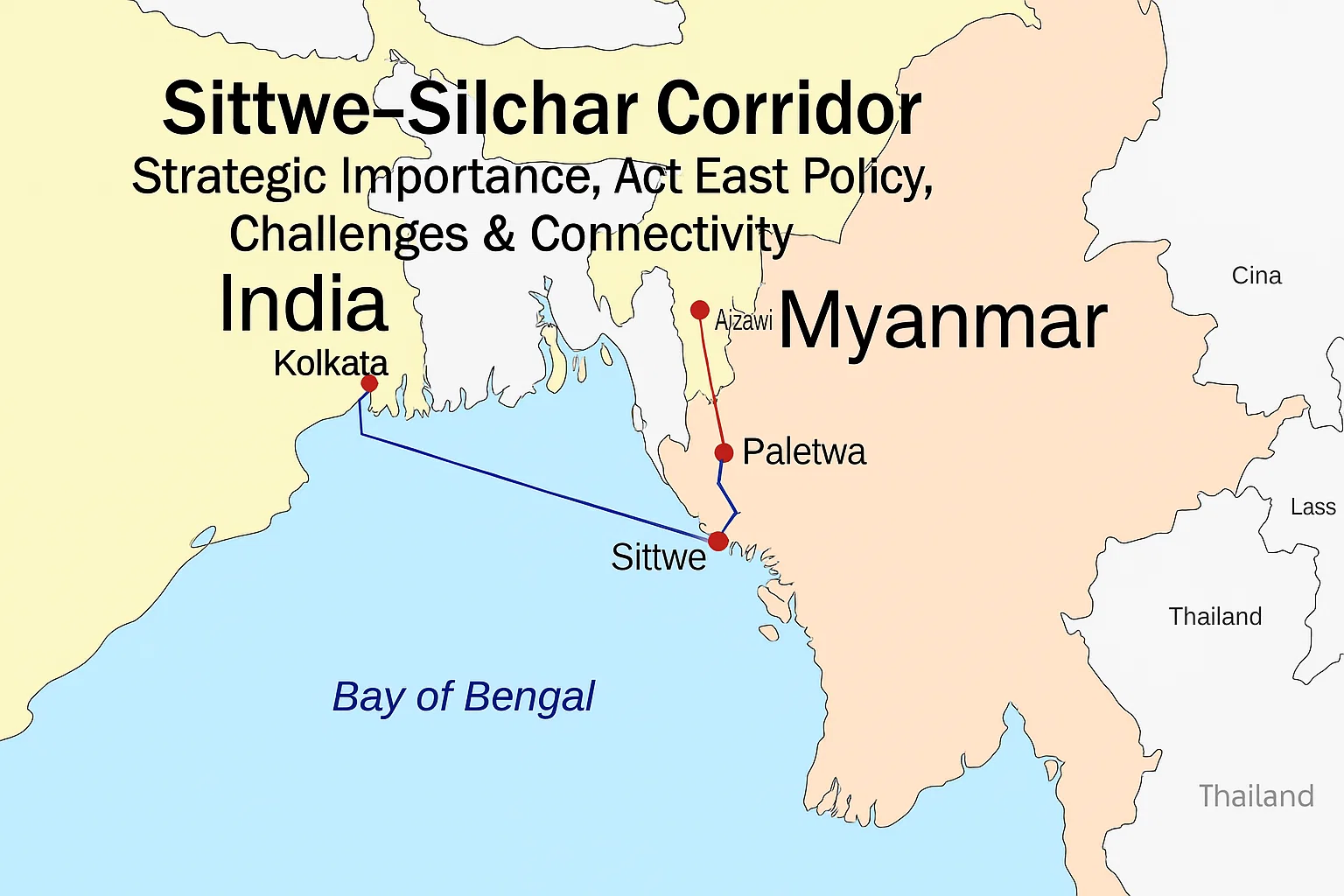Sittwe-Silchar Corridor: Strategic Importance, Act East Policy, Challenges & Connectivity
Explore the significance of the Sittwe-Silchar Corridor, India’s Act East Policy, Kaladan Multi-Modal Transit Transport Project, and the strategic shift from the Siliguri Corridor. Learn about Northeast India’s connectivity challenges, economic integration, and regional security implications.
Sittwe-Silchar Corridor and Act East Policy: Strategic Connectivity Overview
India’s strategic decision to build the Shillong-Silchar highway in April 2025 is a pivotal move to overcome the chronic vulnerability of the Siliguri Corridor.
More on news
- This initiative is intrinsically linked to operationalising the Kaladan Multi-Modal Transit Transport Project (KMMTTP), which connects India’s eastern coast to the Northeast via the Sittwe Port in Myanmar.
- By creating an alternative, sea-based route, India aims to reduce its strategic dependence on a narrow land strip, enhance economic integration with ASEAN, and counterbalance Chinese influence in the Bay of Bengal region.
- This development is a cornerstone of India’s broader Act East Policy, seeking to transform the Northeast from a peripheral borderland into a central hub for regional trade.

What is the Act East Policy?
- The Act East Policy is India’s strategic and diplomatic initiative to bolster economic and strategic ties with Southeast Asia and the wider Indo-Pacific region.
- An evolution of the earlier “Look East Policy,” it emphasises a more proactive and action-oriented approach.
- The policy focuses on enhancing connectivity, trade, cultural exchanges, and security cooperation with ASEAN countries and other regional partners like Japan and Australia.
- A core component is the physical and digital integration of India’s Northeastern states with the dynamic economies of its eastern neighbours, turning a geographical challenge into a strategic advantage.
Why is it essential for Northeast India?
The Act East Policy is essential for Northeast India for two primary reasons:
- Overcoming Geographic Isolation: The region is connected to mainland India by the vulnerable 22-km wide Siliguri Corridor. The Act East Policy provides an alternative, opening up eastern routes through Myanmar, which can ensure uninterrupted access and economic viability.
- Socio-Economic Transformation: By positioning the Northeast as the “gateway to Southeast Asia,” the policy aims to end its economic isolation. It promises to attract investments, develop infrastructure, create jobs, and allow the region to become a participant in regional value chains, exporting its products and importing inputs at lower costs.
What are the major challenges associated with the Northeast?
- Strategic Vulnerability: The heavy reliance on the narrow and susceptible Siliguri Corridor poses a significant security risk.
- Physical Isolation & Infrastructure Deficit: Rugged terrain, frequent landslides, and poor connectivity have historically led to economic stagnation and high logistics costs.
- Internal Instability: The region has grappled with insurgencies and ethnic conflicts, which have hampered development and investor confidence.
- Connectivity with Neighbours: A lack of robust trade and transit routes with neighbouring Myanmar and Bangladesh has perpetuated the region’s isolation from the broader Asian economy.
What efforts have been made to address the challenges?
Successive Indian governments have undertaken several initiatives:
- Infrastructure Development: Significant investments in roads, railways, and air connectivity within the Northeast, such as the ongoing expansion of National Highways.
- Diplomatic Engagements: Signing agreements with Bangladesh for the use of Chittagong and Mongla ports, and with Myanmar for the Kaladan Multi-Modal Transit Transport Project.
- Security and Development Packages: Implementing schemes like the North East Special Infrastructure Development Scheme (NESIDS) to improve social and physical infrastructure while addressing security concerns.
- Institutional Mechanisms: Strengthening the Bay of Bengal Initiative for Multi-Sectoral Technical and Economic Cooperation (BIMSTEC) as a key regional forum.
What efforts have been made in Northeast India for aligning with the Act East Policy?
Specific efforts to align the Northeast with the Act East Policy include:
- The Kaladan Multi-Modal Transit Transport Project (KMMTTP): A flagship project creating a multi-modal link from Kolkata to Mizoram via Sittwe Port in Myanmar, bypassing the Siliguri Corridor.
- The Trilateral Highway: An ambitious project to connect India, Myanmar, and Thailand by road, with extensions envisaged to Cambodia, Laos, and Vietnam.
- Border Haats: Establishing local markets along the India-Bangladesh border to promote cross-border trade and people-to-people contact.
- The Shillong-Silchar Highway: A newly approved access-controlled corridor that will improve internal connectivity within the Northeast and link to the larger KMMTTP network, ensuring goods from Sittwe can reach deeper into the region without relying on transit through Bangladesh.
Subscribe to our Youtube Channel for more Valuable Content – TheStudyias
Download the App to Subscribe to our Courses – Thestudyias
The Source’s Authority and Ownership of the Article is Claimed By THE STUDY IAS BY MANIKANT SINGH



